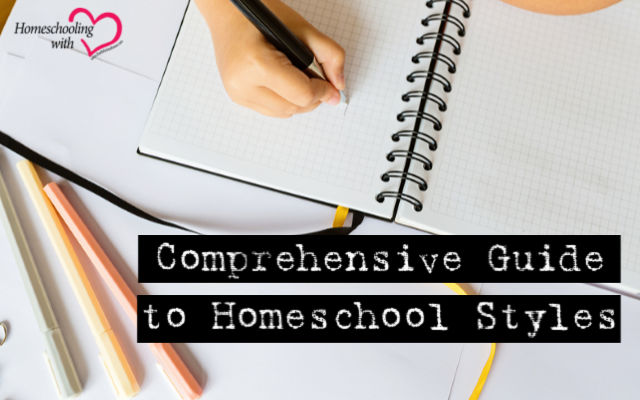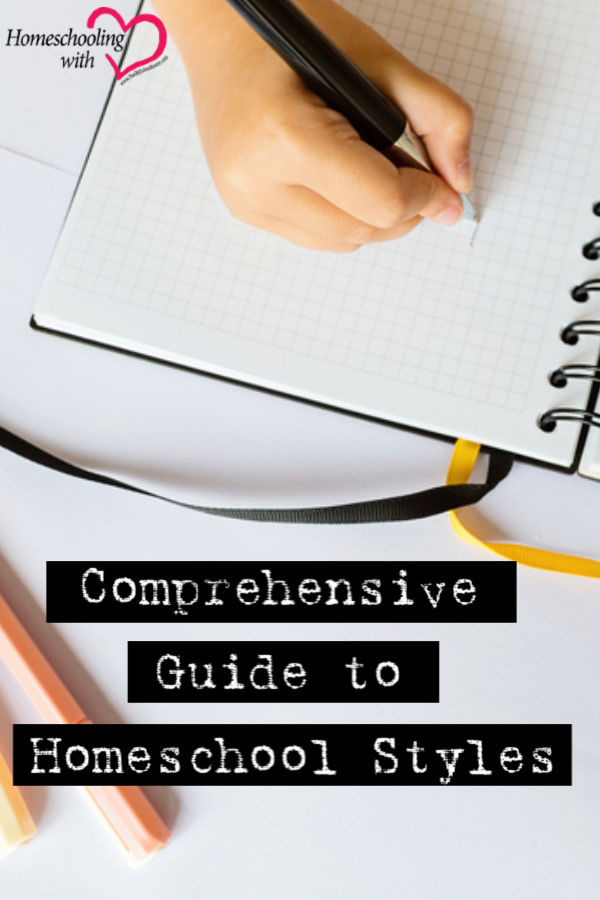Comprehensive Guide to Homeschool Styles


If you had the opportunity to visit 100 homeschools, you would witness 100 different homeschool styles. Each family is unique, and the ability to custom fit your teaching method to suit your own children is one of the many great benefits of home education! While there are no “cookie cutter” homeschools, there are some general style categories including those which are outlined below.
The most popular style is eclectic, which is really a combination of styles. Parents will often incorporate aspects of various approaches depending on the needs of their children and the subjects they are learning. Many families will also change homeschool styles through the years.
-
Classical
Description: The classical method has been around since the Middle Ages and is based on the Latin Trivium of grammar, logic, and rhetoric. These represent three stages of education that children are led through in succession. In the Grammar Stage (elementary), children learn how to learn, focusing on the 3 R’s and memorization. Then they move into the Logic Stage, also called the Dialectic Stage (middle school), where they learn to investigate, reason, and think analytically. Finally, they enter the Rhetoric Stage (high school) where they learn how to use the knowledge they have gained to write and speak with authority.
Benefits: Due to their good grasp of language and their ability to reason, classically trained students are good communicators who can develop a solid argument. They love to learn, and they continue to learn throughout their adult lives.
Curriculum Suggestions:
- Classical Conversations
- Veritas Press
- Memoria Press
You can read about these classical Christian curricula in an article by Rebbecca Devitt at howdoihomeschool.com.
The Old Schoolhouse® Magazine has a free digital Homeschool Supplement, offering an in-depth guide on the homeschooling methods of Classical Christian Education and Charlotte Mason.
-
Charlotte Mason
Description: Charlotte Mason (1842-1923) was a British educator who believed that children are more than “containers” to be filled with knowledge; they are whole people, worthy of respect and deserving of a good education. She preferred “living books” over textbooks and sought to “spread a feast” of liberal arts before each student. She stressed the importance of spending time outdoors and encouraged the use of nature journals. In terms of homeschool styles, the Charlotte Mason method emphasizes narration and discussion, rather than tests, for children to demonstrate what they have learned.
Benefits: Students develop good educational habits that keep them learning throughout life. The use of narration makes them good listeners, speakers, and writers.
Curriculum Suggestions: On her “Everyday Graces” website, Lara Molettiere presents Homeschooling 101: The Charlotte Mason Method. Included in the article is a guide to Charlotte Mason resources.
-
Waldorf
Description: Of all the homeschool styles, Waldorf is one of the least well-known today. It was made popular in Europe in the late 19th and early 20th centuries by Rudolf Steiner. Its focus is on educating the whole child—body, mind, and spirit. Subjects are not separated, and standard textbooks are seldom used especially in the younger grades. Instead, students create their own books. Art, music, and nature are key components of the Waldorf method. The use of television and computers is discouraged; technology is not introduced to the learning environment until high school.
Benefits: A great emphasis is placed on learning by experience, and so children are encouraged to observe their parents in their daily home and work life and learn to imitate mom and dad.
Curriculum Suggestions: You can learn more from an Introduction to Waldorf Homeschooling on the website thehomeschoolmom.com.
-
Montessori
Description: This method was founded by Maria Montessori, a medical doctor and Italian educator in the late 1800s and early 1900s. She observed how children learn and developed a child-centered approach to education that values each child as a unique individual. Children are allowed much unscheduled time so they can be taught to manage their own time. They learn at their own pace and are encouraged to use real tools, rather than toys.
Benefits: Children are free to follow their dreams and learn about the things that interest them through hands-on experience. Mixed ages are taught together which makes this method a good fit for many homeschooling families
Curriculum Suggestions: “Because Montessori is more of a philosophy than a defined program, any parent can create their own Montessori homeschool curriculum” (time4learning.com). For guidance on available materials and a more detailed introduction to this method, you can read Montessori Homeschool at time4learning.com.
-
Unschooling
Description: Some people may think that “unschooling” refers to no education at all, but that is not what it means. Learning still takes place, but it is child-led. The parent is more of a facilitator than a teacher. The premise here is that children are naturally curious, learning every day, and they will learn best when they are free to study what interests them the most. This method emphasizes life experience over formal lessons in the classroom. Students may still choose to have formal lessons on some subjects, but they will be subjects of their choosing that are of interest to them.
Benefits: Students can become experts in their fields of study because they get to devote all their time on subjects that they want to learn.
Curriculum Suggestions: There is no set curriculum for unschooling. However, you can learn more about this educational method by reading Unschooling: Laws & How to Start at time4learning.com. Also, it is important to understand the local laws in your state or province as some do have particular educational standards that must be reached.
-
School at Home
Description: Of all the homeschool styles, this one is considered to be the Traditional Homeschooling approach. It is also referred to as “school-in-a-box.” Traditional homeschool parents generally seek to teach like the public schools teach but to do it better at home. Their issue is not with the teaching methods of the public schools but with some of the content being taught and the overall secular culture of the schools. School at home is a popular style for many Christian families, who believe that God has given the main responsibility for teaching the next generation to parents and not to secular or government institutions. School at Home often looks like public school with students sitting at the kitchen table (or in a classroom in their home), reading textbooks, completing assignments, and taking tests. Many families follow a schedule and use a full curriculum that they either purchased from one company or put together themselves from various sources. Computer and DVD instruction may also be used for some of the courses.
Benefits: This is an excellent method for parents who want their children to keep up with (or be ahead of) the academic standard expected of each grade in public school. When they use a full curriculum, they know what they need to teach every year to keep their students “on track,” and their lesson plans are already made up for them. Also, when planning ahead for college or university, the school-at-home method makes it easier to prepare a traditional transcript of their children’s subjects and grades.
Curriculum Suggestions: SchoolhouseTeachers.com is the curriculum division of The Old Schoolhouse® Magazine. It is now a full curriculum website, offering every core subject for every grade (PreK-12). One Ultimate Membership grants an entire family unlimited access to more than 400 self-paced courses plus many other resources on the site. Lessons can be completed online or downloaded and printed. There are no extra fees, and no textbooks to buy.
-
Eclectic
Description: As stated above, this is the most popular style among homeschooling families, and for each family it is really a custom-made combination of homeschool styles. Parents will incorporate elements from two or more styles that suit their family’s needs. For example, many parents will take a “school at home” approach to subjects like math and reading but use the “unschooling” style for other subjects. In an eclectic homeschool, the mornings will often be devoted to the more formal schoolwork, leaving the afternoon free for hobbies, field trips, and special family time.
Benefits: Parents can ensure that their children remain “on track” with the core subjects they will need for higher education and future employment. At the same time, their kids have the freedom to “follow their dreams” with other subjects and study what interests them. The eclectic style is sometimes referred to as “relaxed” homeschooling, as there is less pressure on parents to cover every subject and less need for children to study certain subjects that cause them great stress.
Curriculum Suggestions: The curriculum needed will depend on the homeschool styles being combined and the subjects being studied. For further guidance, you can read an article on Eclectic Homeschooling by Becton Loveless at educationcorner.com.
Conclusion
There is more than one right way to homeschool. There are many excellent homeschool styles, and the best one is the one that fits best for your family. You don’t need to homeschool the way your friends do; you can use the style that works best for you. Also, you don’t need to be locked into the same style year after year. As your children grow and change, you may find that different homeschool styles work better at different times. Whichever method or combination you choose, please have fun and enjoy the journey because homeschooling is a blessing and your family homeschool is one of a kind!
For Further Reading
The links below will lead to articles with more information on homeschool styles:
https://www.thehomeschoolmom.com/homeschooling-styles/
https://www.homeschool.com/homeschooling-methods/
https://simplycharlottemason.com/five-homeschooling-styles/
https://pambarnhill.com/guide-to-homeschool-methods/













































